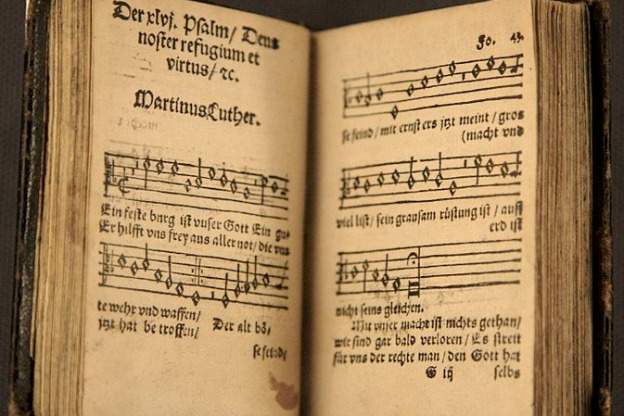
Protestant Reformation
Alongside its social, political and theological impacts, the Protestant Reformation also redefined music’s role in the 16th century church. Martin Luther’s reforms encouraged congregational participation with straightforward melodies and music sung in the common language of the people. For Luther, music was a powerful theological tool through which religious tenets of belief and devotion could be expressed. Luther himself translated, revised, and reworked Catholic texts and German folk melodies for reformed congregations to sing. Soon there was a major influx in the publication of hymn books through which a canon of German chorales developed and spread.
An early Lutheran hymnal was a collection called the Achtliederbuch. Published in 1524, this, and other hymn collections like it included texts and chorale melodies both by Martin Luther and many of his colleagues. These became central to Lutheran hymnody on which later composers created all manner of cantatas, preludes, fantasias and the like. Telemann was one such composer who incorporated chorale tunes and hymn stanzas into his new 18th century church music. And, on their 2013 recording, the Baroque Orchestra of Saxony, together with the Bach Consort of Leipzig presents a variety of Telemann’s Luther cantatas.
Telemann Luther Cantatas
Telemann’s Es wollt uns Gott genädig sein is based on a tune already circulating in 1524. The original text is Luther’s paraphrase of Psalm 67, and the tune is derived from a Marian hymn. In Telemann’s version, the cantata opens with a sinfonia on the chorale tune and is followed by 3 stanzas of text that the 18th c. clergyman and poet Neumeister reworked from Luther’s text. After the sinfonia, Telemann writes a straightforward four voiced setting of the chorale, followed by a marvelous duet on the same text for soprano and bass.
Probably the most recognizably Lutheran of all tunes is found in the second stanza of Wertes Zion, sei getrost which sets the chorale, Ein feste Burg ist unser Gott (A Mighty Fortress is our God) of which Luther is author of both words and melody. Telemann’s setting is done appropriately with trumpets and drums for this so-called “Battle Hymn of the Reformation.” But even more musically interesting moments with trumpets and drums in this canata can be heard in the Dictum.
Bach Lutheran Masses
We’ve been talking about Luther’s reforms and their effect on Church music, and one major change was in Mass settings. The Mass usually consists of a Kyrie, Gloria, Credo, Sanctus and Agnues Dei: boundries within which composers for hundreds of years have worked. But in the reformed Lutheran tradition, this structure underwent some changes. By the time of Bach, church services consisted of vernacular German chorales alongside fragmented portions of the Latin mass. The Kyrie and Gloria followed the formula in Latin, but the Credo was often intoned in the vernacular German, and the Sanctus and Agnus Dei became optional. Thus evolved what we term “The Lutheran Mass” simply, a short mass in Latin with composed music only for the Kyrie and Gloria.
We know of 5 of these so called Lutheran masses that Bach wrote—four of them survive in their entirety—and two of them are included on this recording from The Sixteen. Bach’s cantata 102 is also included on this disc, but it’s not simply for the sake of variety. Bach compiled all of the masses largely from pieces he had already written, most often cantata movements transcribed or reworked.
It is very interesting how the text changes the music. And there are examples galore to compare on this disc of borrowings and transcriptions, like the Qui tollis soprano aria of the F major mass, and the Aria Weh der Seele, die den Schaden from cantata 102 or the Quoniam with violin obbligato changed to flute obbligato in the similar tenor aria Erschrecke doch in the cantata…Here’s an interesting statistic: 20 out of 24 movements in the four Lutheran Masses BWV 233-236 take material from pre-existing cantatas. The Gloria from the F major mass, though, is not known to have any other equivalent in Bach’s work
Despite their ensemble name, The Sixteen, only 8 singers perform on this recording. The clarity of sound they achieve, together with a 20 piece band lends a very convincing argument for small forces in Bach’s church music. In addition to this recording, the ensemble has also released volume II of the set.









